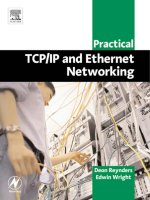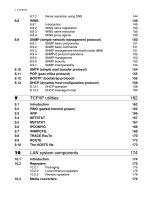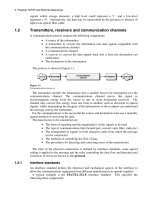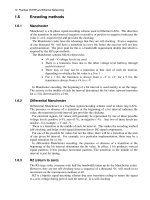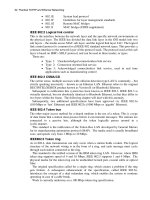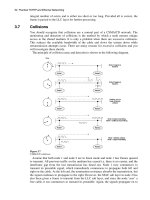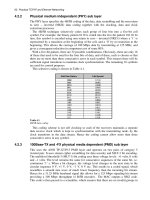Practical TCP/IP and Ethernet Networking- P20 ppt
Bạn đang xem bản rút gọn của tài liệu. Xem và tải ngay bản đầy đủ của tài liệu tại đây (426.75 KB, 10 trang )
6XGIZOIGR:)6/6GTJ+ZNKXTKZ4KZ]UXQOTM
85;:+
The route command is used to configure network routing tables. This may be a tedious
task but is sometimes necessary for reasons of security or because a specific route has to
be added.
The following shows the route options.
C:\WINDOWS.000>route /?
Manipulates network routing tables.
ROUTE [-f] [command [destination] [MASK netmask] [gateway] [METRIC metric]]
-f Clears the routing tables of all gateway entries. If this is used
in conjunction with one of the commands, the tables are
cleared prior to running the command.
command Must be one of four:
PRINT Prints a route
ADD Adds a route
DELETE Deletes a route
CHANGE Modifies an existing route
destination Specifies the destination host.
MASK Specifies that the next parameter is the ‘netmask’ value.
netmask Specifies a subnet mask value to be associated with this route
entry. If not specified, it defaults to 255.255.255.255.
METRIC Specifies that the next parameter ‘metric’ is the cost for this
destination
All symbolic names used for destination are looked up in the network database file
NETWORKS. The symbolic names for gateway are looked up in the host name database
file HOSTS.
If the command is PRINT or DELETE, wildcards may be used for the destination and
gateway, or the gateway argument may be omitted.
Diagnostic notes:
Invalid MASK generates an error, that is when (DEST & MASK) != DEST.
Example> route ADD 255.0.0.0 157.0.0.0 MASK 155.0.0.0
157.55.80.1
The route addition failed: 87
Examples:
> route PRINT
> route ADD 157.0.0.0 MASK 255.0.0.0 157.55.80.1 METRIC 3
^destination ^mask ^gateway ^metric
> route PRINT
> route DELETE 157.0.0.0
> route PRINT
C:\WINDOWS.000>
The route table exists on both hosts and routers. An individual entry is read from left to
right as follows: ‘If a message is destined for network 192.100.100.0, with subnet mask
255.255.255.0, then route it through to the gateway address 192.100.100.1’. Remember
that a HostID equal to 0, as used here, does not refer to a specific host but rather to the
network as a whole.
Routes can also be added with the route add and route delete commands.
Route add 192.100.100.0 mask 255.255.255.0 192.100.100.1 will add a route and
Route delete 192.100.100.0 will delete a particular route. Manual adding of routes are
sometimes necessary, for example in the case where the installation of dial-up proxy
:)6/6[ZOROZOKY
server software on a given host sometimes overwrites the existing default gateway setting
on that host in order to ‘point’ to the Internet service provider’s default gateway. This
makes it impossible for the host to reach an existing adjacent network across the
intermediate router, unless a manual entry is made. If said entry ‘does the job’ but
disappears when the host is re-booted, the appropriate route command needs to be
included in the autoexec.bat file.
The following response was obtained from the route print command.
Active routes:
Network Address Netmask Gateway Address Interface Metric
127.0.0.0 255.0.0.0 127.0.0.1 1 27.0.0.1 1
207.194.66.96 255.255.255.224 207.194.66.100 207.194.66.100 1
207.194.66.100 255.255.255.255 127.0.0.1 127.0.0.1 1
207.194.66.255 255.255.255.255 207.194.66.100 207.194.66.100 1
224.0.0.0 224.0.0.0 207.194.66.100 207.194.66.100 1
255.255.255.255 255.255.255.255 207.194.66.100 0.0.0.0 1
C:\WINDOWS.000>
:NK.59:9LORK
The hosts file is used on UNIX and Windows systems to resolve the mapping of a ‘name’
(any given name) to an IP address.
The following is an example of a typical Windows hosts file. This file is saved in the
same directory as Windows itself as c:\windows\hosts. If a user is uncertain about the
correct format of the entries, a sample file can be found at c:\windows\hosts.sam. Note
that, as a matter of convenience, the hosts sample file can be edited as in the
accompanying example, but it MUST then be saved as hosts only, i.e. without the.
same extension.
In the example, host 192.100.100.2 can simply be interrogated by typing ping john.
Figure 9.6
The Hosts file (courtesy of Microsoft Corporation)
10
LAN system components
Objectives
When you have completed this chapter you should be able to:
• Explain the basic function of each of the devices listed under 10.1
• Explain the fundamental differences between the operation and application
of switches (layer 2 and 3), bridges and routers
10.1 Introduction
In the design of an Ethernet system there are a number of different components that can
be used. These include:
• Repeaters
• Media converters
• Bridges
• Hubs
• Switches
• Routers
• Gateways
• Print servers
• Terminal servers
• Remote access servers
• Time servers
• Thin servers
The lengths of LAN segments are limited due to physical and collision domain
constraints and there is often a need to increase this range. This can be achieved by
means of a number of interconnecting devices, ranging from repeaters to gateways. It
may also be necessary to partition an existing network into separate networks for reasons
of security or traffic overload.
LAN system components 175
In modern network devices the functions mentioned above are often mixed:
• A shared 10BaseT hub is, in fact, a multi-port repeater
• A layer II switch is essentially a multi-port bridge
• Segmentable and dual-speed shared hubs make use of internal bridges
• Switches can function as bridges, a two-port switch being none other than a
bridge
• Layer III switches function as routers
These examples are not meant to confuse the reader, but serve to emphasize the fact
that the functions should be understood, rather than the ‘boxes’ in which they
are packaged.
10.2 Repeaters
A repeater operates at the physical layer of the OSI model (layer 1) and simply
retransmits incoming electrical signals. This involves amplifying and re-timing the
signals received on one segment onto all other segments, without considering any
possible collisions. All segments need to operate with the same media access mechanism
and the repeater is unconcerned with the meaning of the individual bits in the packets.
Collisions, truncated packets or electrical noise on one segment are transmitted onto all
other segments.
10.2.1 Packaging
Repeaters are packaged either as stand-alone units (i.e. desktop models or small cigarette
package-sized units) or 19" rack-mount units. Some of these can link two segments only,
while larger rack-mount modular units (called Concentrators) are used for linking
multiple segments. Regardless of packaging, repeaters can be classified either as local
repeaters (for linking network segments that are physically in close proximity), or as
remote repeaters for linking segments that are some distance apart.
Figure 10.1
Repeater application
10.2.2 Local Ethernet repeaters
Several options are available:
• Two-port local repeaters offer most combinations of 10Base5, 10Base2,
10BaseT and 10Base-FL such as 10Base5/10Base5, 10Base2/10Base2,
10Base5/10Base2, 10Base2/10BaseT, 10BaseT/10BaseT and 10Base-
FL/10Base-FL. By using such devices (often called boosters or extenders)
one can, for example, extend the distance between a computer and a
10BaseT hub by up to 100 m, or extend a 10Base-FL link between two
devices (such as bridges) by up to 2 km
176 Practical TCP/IP and Ethernet Networking
• Multi-port local repeaters offer several ports of the same type (e.g. 4×
10Base2 or 8× 10Base5) in one unit, often with one additional connector of a
different type (e.g. 10Base2 for a 10Base5 repeater). In the case of 10BaseT
the cheapest solution is to use an off-the-shelf 10BaseT shared hub, which is
effectively a multi-port repeater
• Multi-port local repeaters are also available as chassis-type units; i.e. as
frames with common back planes and removable units. An advantage of this
approach is that 10Base2, 10Base5, 10BaseT and 10Base-FL can be mixed
in one unit, with an option of SNMP management for the overall unit. These
are also referred to as Concentrators
10.2.3 Remote repeaters
Remote repeaters, on the other hand, have to be used in pairs with one repeater connected
to each network segment and a fiber-optic link between the repeaters. On the network
side they typically offer 10Base5, 10Base2 and 10BaseT. On the interconnecting side the
choices include ‘single pair Ethernet’, using telephone cable up to 457 m in length, or
single mode/multimode optic fiber, with various connector options. With 10Base-FL
(backwards compatible with the old FOIRL standard), this distance can be up to 1.6 km.
In conclusion it must be emphasized that although repeaters are probably the cheapest
way to extend a network, they do so without separating the collision domains, or network
traffic. They simply extend the physical size of the network. All segments joined by
repeaters therefore share the same bandwidth and collision domain.
10.3 Media converters
Media converters are essentially repeaters, but interconnect mixed media viz. copper and
fiber. An example would be 10BaseT/10Base-FL. As in the case of repeaters, they are
available in single and multi-port options, and in stand-alone or chassis type
configurations. The latter option often features remote management via SNMP.
Figure 10.2
Media converter application
Models may vary between manufacturers, but generally Ethernet media converters
support:
• 10 Mbps (10Base2, 10BaseT, 10Base-FL – single and multi-mode)
• 100 Mbps (fast) Ethernet (100Base-TX, 100Base-FX – single and
multimode)
• 1000 Mbps (gigabit) Ethernet (single and multimode)
An added advantage of the fast and gigabit Ethernet media converters is that they
support full-duplex operation that effectively doubles the available bandwidth.
LAN system components 177
10.4 Bridges
Bridges operate at the data link layer of the OSI model (layer 2) and are used to connect
two separate networks to form a single large continuous LAN. The overall network,
however, still remains one network with a single network ID (NetID). The bridge only
divides the network up into two segments, each with its own collision domain and each
retaining its full (say, 10 Mbps) bandwidth. Broadcast transmissions are seen by all
nodes, on both sides of the bridge.
The bridge exists as a node on each network and passes only valid messages across to
destination addresses on the other network. The decision as to whether or not a frame
should be passed across the bridge is based on the layer 2 address, i.e. the media (MAC)
address. The bridge stores the frame from one network and examines its destination MAC
address to determine whether it should be forwarded across the bridge.
Bridges can be classified as either MAC or LLC bridges, the MAC sublayer being the
lower half of the data link layer and the LLC sublayer being the upper half. For MAC
bridges the media access control mechanism on both sides must be identical; thus it can
bridge only Ethernet to Ethernet, token ring to token ring and so on. For LLC bridges, the
data link protocol must be identical on both sides of the bridge (e.g. IEEE 802.2 LLC);
however, the physical layers or MAC sublayers do not necessarily have to be the same.
Thus the bridge isolates the media access mechanisms of the networks. Data can therefore
be transferred, for example, between Ethernet and token ring LANs. In this case,
collisions on the Ethernet system do not cross the bridge nor do the tokens.
Bridges can be used to extend the length of a network (as with repeaters) but in addition
they improve network performance. For example, if a network is demonstrating fairly
slow response times, the nodes that mainly communicate with each other can be grouped
together on one segment and the remaining nodes can be grouped together in another
segment. The busy segment may not see much improvement in response rates (as it is
already quite busy) but the lower activity segment may see quite an improvement in
response times. Bridges should be designed so that 80% or more of the traffic is within
the LAN and only 20% cross the bridge. Stations generating excessive traffic should be
identified by a protocol analyzer and relocated to another LAN.
10.4.1 Intelligent bridges
Intelligent bridges (also referred to as transparent or spanning-tree bridges) are the most
commonly used bridges because they are very efficient in operation and do not need to be
taught the network topology. A transparent bridge learns and maintains two address lists
corresponding to each network it is connected to. When a frame arrives from the one
Ethernet network, its source address is added to the list of source addresses for that
network. The destination address is then compared to that of the two lists of addresses for
each network and a decision made whether to transmit the frame onto the other network.
If no corresponding address to the destination node is recorded in either of these two lists
the message is retransmitted to all other bridge outputs (flooding), to ensure the message
is delivered to the correct network. Over a period of time, the bridge learns all the
addresses on each network and thus avoids unnecessary traffic on the other network. The
bridge also maintains time out data for each entry to ensure the table is kept up to date
and old entries purged.
Transparent bridges cannot have loops that could cause endless circulation of packets.
If the network contains bridges that could form a loop as shown in Figure 10.3, one of the
bridges (C) needs to be made redundant and deactivated.
178 Practical TCP/IP and Ethernet Networking
Figure 10.3
Avoidance of loops in bridge networks
The spanning tree algorithm (IEEE 802.1d) is used to manage paths between segments
having redundant bridges. This algorithm designates one bridge in the spanning tree as
the root and all other bridges transmit frames towards the root using a least cost metric.
Redundant bridges can be reactivated if the network topology changes.
10.4.2 Source-routing bridges
Source-routing (SR) bridges are popular for IBM token ring networks. In these networks,
the sender must determine the best path to the destination. This is done by sending a
discovery frame that circulates the network and arrives at the destination with a record of
the path token. These frames are returned to the sender who can then select the best path.
Once the path has been discovered, the source updates its routing table and includes the
path details in the routing information field in the transmitted frame.
10.4.3 SRT and translational bridges
When connecting Ethernet networks to token ring networks, either
source-routing
transparent
(SRT) bridges or translational bridges are used. SRT bridges are a
combination of a transparent and source-routing bridge, and are used to interconnect
Ethernet (IEEE802.3) and token ring (IEE802.5) networks. It uses source routing of the
data frame if it contains routing information; otherwise it reverts to transparent bridging.
Translational bridges, on the other hand, translate the routing information to allow
source-routing networks to bridge to transparent networks. The IBM 8209 is an example
of this type of bridge.
10.4.4 Local vs remote bridges
Local bridges are devices that have two network ports and hence interconnect two
adjacent networks at one point. This function is currently often performed by switches,
being essentially intelligent multi-port bridges.
A very useful type of local bridge is a 10/100 Mbps Ethernet bridge, which allows
interconnection of 10BaseT, 100Base-TX and 100Base-FX networks, thereby performing
the required speed translation. These bridges typically provide full-duplex operation on
LAN system components 179
100Base-TX and 100Base-FX, and employ internal buffers to prevent saturation of the
10BaseT port.
Remote bridges, on the other hand, operate in pairs with some form of interconnection
between them. This interconnection can be with or without modems, and include RS-
232/V.24, V.35, RS-422, RS-530, X.21, 4-wire, or fiber (both single and multi-mode).
The distance between bridges can typically be up to 1.6 km.
Figure 10.4
Remote bridge application
10.5 Hubs
Hubs are used to interconnect hosts in a physical star configuration. This section will deal
with Ethernet hubs, which are of the 10/100/100BaseT variety. They are available in
many configurations, some of which will be discussed below.
10.5.1 Desktop vs stackable hubs
Smaller desktop units are intended for stand-alone applications, and typically have 5 to 8
ports. Some 10BaseT desktop models have an additional 10Base2 port. These devices are
often called workgroup hubs.
Stackable hubs, on the other hand, typically have up to 24 ports and can be physically
stacked and interconnected to act as one large hub without any repeater count restrictions.
These stacks are often mounted in 19-inch cabinets.
180 Practical TCP/IP and Ethernet Networking
Figure 10.5
10BaseT hub interconnection
10.5.2 Shared vs switched hubs
Shared hubs interconnect all ports on the hub in order to form a logical bus. This is
typical of the cheaper workgroup hubs. All hosts connected to the hub share the available
bandwidth since they all form part of the same collision domain.
Although they physically look alike, switched hubs (better known as switches) allow
each port to retain and share its full bandwidth only with the hosts connected to that port.
Each port (and the segment connected to that port) functions as a separate collision
domain. This attribute will be discussed in more detail in the section on switches.
10.5.3 Managed hubs
Managed hubs have an on-board processor with its own MAC and IP address. Once the
hub has been set up via a PC on the hub’s serial (COM) port, it can be monitored and
controlled via the network using SNMP or RMON. The user can perform activities such
as enabling/disabling individual ports, performing segmentation (see next section),
monitoring the traffic on a given port, or setting alarm conditions for a given port.
10.5.4 Segmentable hubs
On a non-segmentable (i.e. shared) hub, all hosts share the same bandwidth. On a
segmentable hub, however, the ports can be grouped, under software control, into several
shared groups. All hosts on each segment then share the full bandwidth on that segment,
which means that a 24-port 10BaseT hub segmented into 4 groups effectively supports 40
Mbps. The configured segments are internally connected via bridges, so that all ports can
still communicate with each other if needed.
LAN system components 181
10.5.5 Dual-speed hubs
Some hubs offer dual-speed ports, e.g. 10BaseT/100Base-T. These ports are auto-
configured, i.e. each port senses the speed of the NIC connected to it, and adjusts its own
speed accordingly. All the 10BaseT ports connect to a common low-speed internal
segment, while all the 100BaseT ports connect to a common high-speed internal segment.
The two internal segments are interconnected via a speed-matching bridge.
10.5.6 Modular hubs
Some stackable hubs are modular, allowing the user to configure the hub by plugging in a
separate module for each port. Ethernet options typically include both 10 and 100 Mbps,
with either copper or fiber. These hubs are sometimes referred to as chassis hubs.
10.5.7 Hub interconnection
Stackable hubs are best interconnected by means of special stacking cables attached to the
appropriate connectors on the back of the chassis.
An alternative method for non-stackable hubs is by ‘daisy-chaining’ an interconnecting
port on each hub by means of a UTP patch cord. Care has to be taken not to connect the
transmit pins on the ports together (and, for that matter, the receive pins) – it simply will
not work. This is similar to interconnecting two COM ports with a ‘straight’ cable i.e.
without a null modem. Connect transmit to receive and vice versa by (a) using a
crossover cable and interconnecting two ‘normal’ ports, or (b) using a normal (‘straight’)
cable and utilizing a crossover port on one of the hubs. Some hubs have a dedicated
uplink (crossover) port while others have a port that can be manually switched into
crossover mode.
A third method that can be used on hubs with a 10Base2 port is to create a backbone.
Attach a BNC T-piece to each hub, and interconnect the T-pieces with RG 58 coax cable.
The open connections on the extreme ends of the backbone obviously have to
be terminated.
Fast Ethernet hubs need to be deployed with caution because the inherent propagation
delay of the hub is significant in terms of the 5.12 microsecond collision domain size.
Fast Ethernet hubs are classified as class I, II or II+, and the class dictates the number of
hubs that can be interconnected. For example, class II dictates that there may be no more
than two hubs between any given pair of nodes, that the maximum distance between the
two hubs shall not exceed 5 m, and that the maximum distance between any two nodes
shall not exceed 205 m. The safest approach, however, is to follow the guidelines of each
manufacturer.
